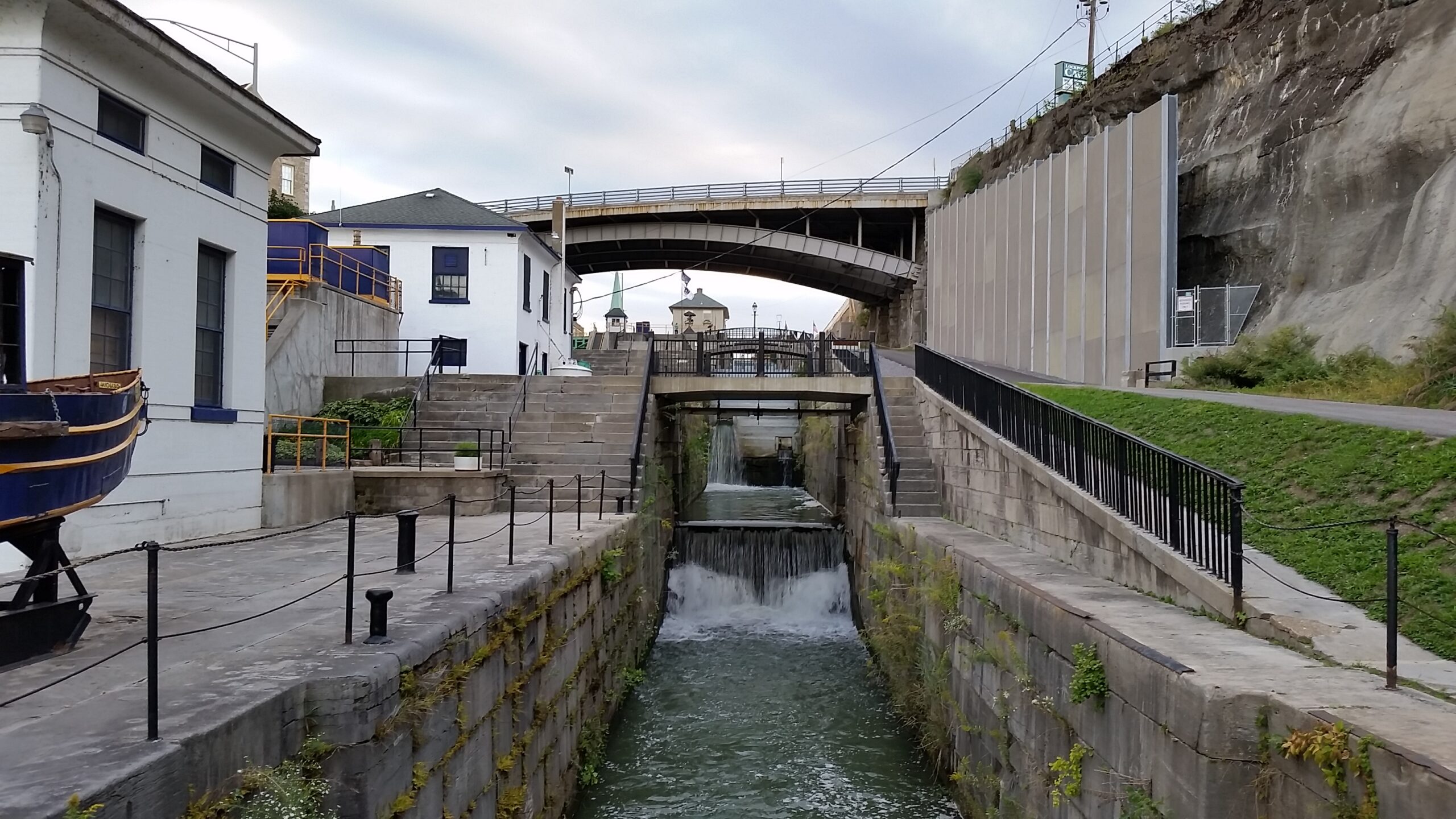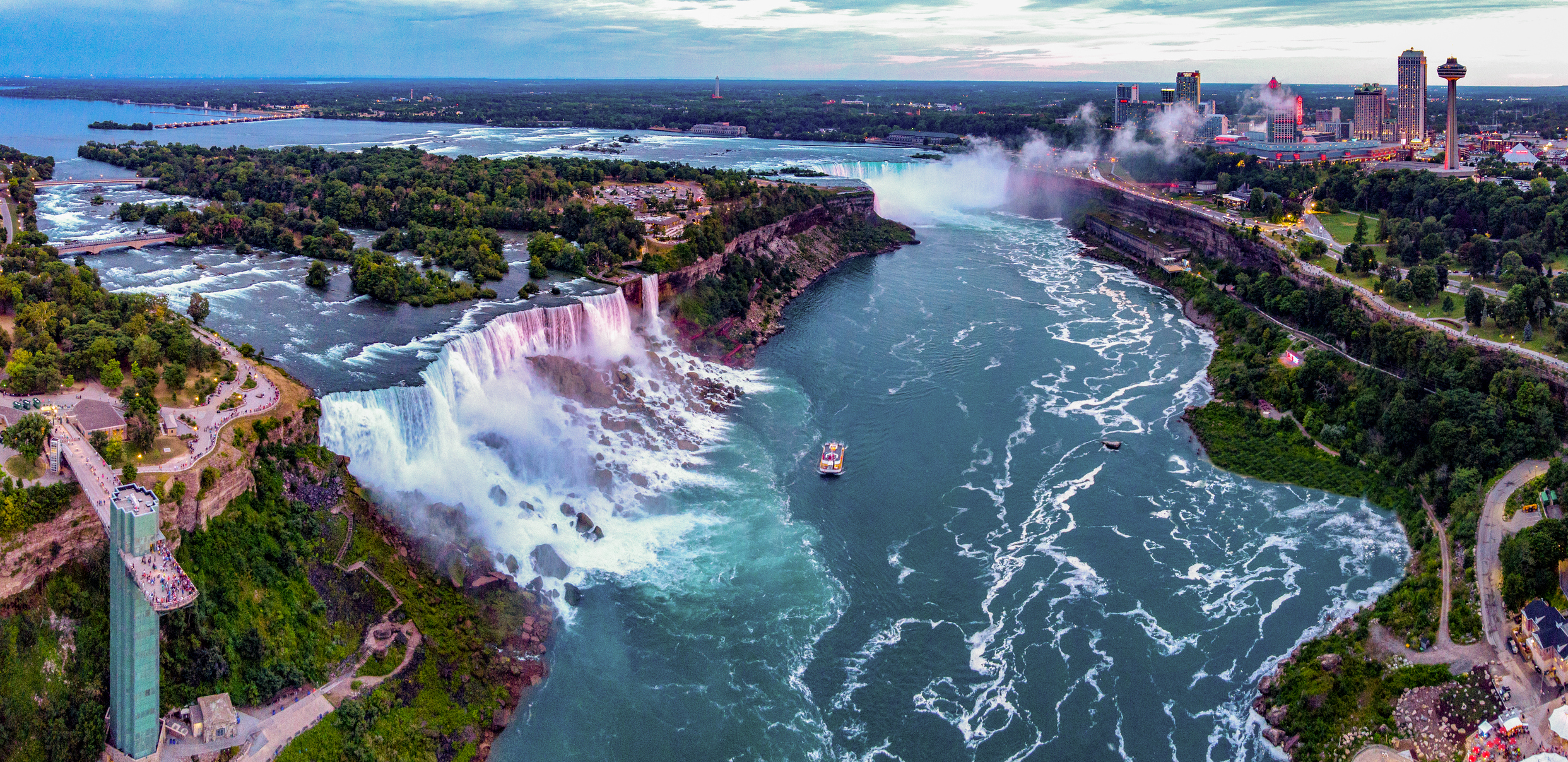Niagara Falls Facts
Niagara Falls is actually made up of three waterfalls: Horseshoe Falls, American Falls and Bridal Veil Falls. American Falls and the much smaller Bridal Veil Falls are located on the United States side. Horseshoe Falls, the biggest of them all, skirts both the U.S. and Canada. Together they represent the highest source of hydroelectric power of any waterfall or body of water within the U.S. And not surprisingly, Horseshoe Falls ranks as the most powerful waterfall in North America; yes indeed–that would be the one with the highest flow rate of them all.
Before tourism became synonymous with Niagara Falls, man was attempting to harness the power behind the falls and the mighty Niagara River that feeds them in order to operate mills. As early as the mid 1700s, Niagara energy was tapped. With the development of electrical power, the first hydroelectric generating station was built in Niagara Falls in 1881. More hydropower plants were created, making it at one point the largest hydropower facility in the western world. Today Niagara Falls is still an electricity producer extraordinaire!

Depending on the season, between 50% and 70% of the Niagara River’s flow is diverted before returning to the river well past the falls. All of this occurs upstream in four huge tunnels; the water passes through turbines, which generate electricity. It’s all highly sophisticated–so much so, in fact, that they can regulate exactly how much water flows over the falls at any given time. Thank goodness for their many adjustments, which allow for the wow factor to be high during the day at the height of the tourism season (in the summer). The flow in the winter, however, is greatly diminished. It’s still awe-inspiring then, especially when so much of the falls freeze and create wondrous formations that resemble ice castles. (The water never completely freezes though; there is always a constant flow underneath.)
Formed when glaciers receded at the end of the last ice age, water from the newly formed Great Lakes carved a path that lead to the Atlantic Ocean. Known as the Niagara Escarpment (or cliffs) from which the water descends, this pathway is marked by Niagara Falls, awe-inspiring falls that have left people wonderstruck for ages.
It’s largely the beauty of Niagara Falls that has been drawing people here from all over the world. The contrast of the bright-white water crashing into the verdant water of the Niagara River heightens the drama of this geological wonder. Indeed the falls–as well as the surrounding area including picturesque Lake Erie–beg to be painted, captured on film or just recorded fleetingly on your iPhone. (The greenish color of the water comes from dissolved salts and ground rock produced by the erosive power of the falls.)

These Falls were the most common subject in eighteenth and nineteenth century European and American landscape paintings. Artists came from all over to capture the magnificence of Niagara Falls. Remember that that was before photography became commonplace; such paintings also served an educational purpose. Then once photography emerged, everyone one from professional photographers to camera-toting tourists attempted to seize the majesty of the falls.
Niagara Falls has also played a prominent role in a number of films and commercials. “Niagara,” the 1953 movie starring Marilyn Monroe, ranks among the best known. This incited a spike in tourism and ever since Niagara Falls has been an increasingly popular destination for vacationers and honeymooners alike.
Such attractions–especially ones of such monolithic proportions–serve as magnets for the most daring adventure seekers and also sadly, the most stupid. Since 1859, tightrope walkers have made Niagara Gorge their prize, most of which crossed successfully. (Most, but not all unfortunately.) In 1896, tightrope crossings of the falls became prohibited until 2012 when Nick Wallenda obtained special permission from both the United States and Canadian governments. He crossed at night in a highly televised–and heart pumping–spectacle. It was supposedly the longest tightrope walk in history.
Going over the falls in a barrel didn’t take place until 1901 when a 63-year-old lady, a former schoolteacher, survived the plunge with just some scrapes and bruises. Others followed, young and old, wise and foolish, with mixed results. Some went in canoes, Jet Skis, inflatable balls–you name it. One even fell in accidentally (with a life preserver) and survived. Word of warning:It is both illegal and not very smart to throw yourself into the churning cauldron of Niagara Falls. (Surprisingly though fish survive going over the falls due to the cushioning effect of the water. Go figure.)
No matter the season, the falls are always magical though. When you go, plan to see them by day and also by night when they are illuminated by an impressive array of lights. If you’re sensitive to sound, you may want to bring earplugs although most stand rapt by the thunderous rushing of water over the falls.
The volume is cranked up every night at 10pm during the season when you can stand (or sit, if you’re lucky) in awe of a spectacular fireworks display over the falls. Outside of summer, the show takes place on the weekends and some holidays that land on Mondays. Best to check in advance because weather can also interfere with the event.
People often ask which side to experience–the Canadian side or the American side? Just like taking in the falls by day and night, a trip to Niagara Falls warrants a visit to both Canada and the United States. The Rainbow Bridge is the best way to make that happen. Opened in 1941, it serves as the gateway between the cities of Niagara Falls. For a small toll, you can cross it by foot, on a bike, in a car or an RV. Just be sure to bring your passport!
No matter how you take in Niagara Falls, be mindful that they are an ever evolving force of nature that many great people have fought to preserve. During the 1880s, sightseers were restricted in viewing the falls due to the amount of industrialization that had taken hold of the area. Fortunately a group of preservationists prevailed and spared Niagara Falls from ruin. In 1985, the Niagara Reservation, New York’s first state park, was formed, sparing further development of one of the most pristine places in the world. The Queen Victoria Niagara Falls Park was established in Ontario also that year with the same goals in mind.
Erosion control has been a part of the preservation efforts as well. Can you imagine Niagara Falls being shut off? Well, it was in 1969. Actually the U.S. Army Corps of Engineers shut off American Falls by creating a dam that diverted the flow to Horseshoe Falls. Check out pictures from that era and you’ll be astonished. They were able to undertake some work to ward off erosion and shore up the falls but there’s no doubt that with every year that passes, more and more is worn away.
You better plan your trip before there’s nothing but a trickle left to Niagara Falls! Hahaha. Go and have lots of fun and be sure to bring your rain gear even if rain is not in the forecast.


